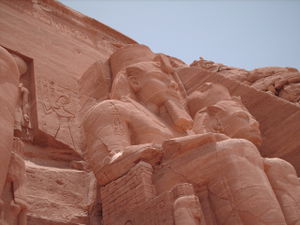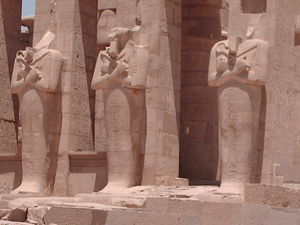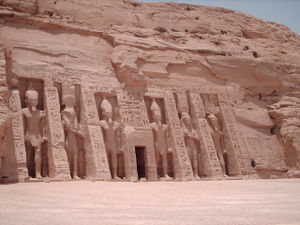Difference between revisions of "Why Was Ramesses II “Great” and How Did He Influence the History of the Ancient Near East"
m (insert middle ad) |
|||
| Line 34: | Line 34: | ||
Ramesses II had more mortuary temples built than any other Egyptian king. <ref> Haeny, Gerhard. “New Kingdom ‘Mortuary Temples’ and ‘Mansions of Millions of Years.’” Temples of Ancient Egypt, edited by Byron E. Shaffer (Ithaca, New York: Cornell University Press, 1997), p. 115 </ref> Among the mortuary temples that Ramesses II had built throughout Egypt were the “Ramesseum” on the west bank of the Nile River near Thebes, an addition to the massive Karnak Temple in Thebes, and the Luxor Temple also in Thebes. Construction of the Luxor Temple began during the reign of Amenhotep III (ruled ca. 1403-1364 BC), but later became known as Ramesses II’s temple due to the large amount of work he did there, which included a pylon and courtyard at the north end and several colossal statues of the king. <ref> Bell, Laney. “The New Kingdom ‘Divine’ Temple: the Example of Luxor.” Temples of Ancient Egypt, edited by Byron E. Shaffer (Ithaca, New York: Cornell University Press, 1997), pgs. 148-52</ref> The Luxor Temple served as the national shrine for the cult of the deified Ramesses II throughout the remainder of pharaonic history. | Ramesses II had more mortuary temples built than any other Egyptian king. <ref> Haeny, Gerhard. “New Kingdom ‘Mortuary Temples’ and ‘Mansions of Millions of Years.’” Temples of Ancient Egypt, edited by Byron E. Shaffer (Ithaca, New York: Cornell University Press, 1997), p. 115 </ref> Among the mortuary temples that Ramesses II had built throughout Egypt were the “Ramesseum” on the west bank of the Nile River near Thebes, an addition to the massive Karnak Temple in Thebes, and the Luxor Temple also in Thebes. Construction of the Luxor Temple began during the reign of Amenhotep III (ruled ca. 1403-1364 BC), but later became known as Ramesses II’s temple due to the large amount of work he did there, which included a pylon and courtyard at the north end and several colossal statues of the king. <ref> Bell, Laney. “The New Kingdom ‘Divine’ Temple: the Example of Luxor.” Temples of Ancient Egypt, edited by Byron E. Shaffer (Ithaca, New York: Cornell University Press, 1997), pgs. 148-52</ref> The Luxor Temple served as the national shrine for the cult of the deified Ramesses II throughout the remainder of pharaonic history. | ||
| + | |||
| + | <dh-ad/> | ||
Ramesses II’s building activities also extended outside of the confines of Egypt proper. He built a number of mortuary temples between the First and Second Cataracts of the Nile River, which was the traditional boundary that separated Egypt from Nubia. The most impressive of all of the boundary temples was the one that is located near the modern town of Abu Simbel. The temple was cut into a sandstone cliff above the Nile River with four nearly seventy foot high seated statues of Ramesses II proudly keeping guard over all who enter his land. <ref> Robins, Gay. The Art of Ancient Egypt (Cambridge, Massachusetts: Harvard University Press, 2000), p. 181</ref> Ramesses II was clearly prolific in his construction activities, which helped secure his legacy and influenced Egypt, but he was just as prolific in his familial affairs. | Ramesses II’s building activities also extended outside of the confines of Egypt proper. He built a number of mortuary temples between the First and Second Cataracts of the Nile River, which was the traditional boundary that separated Egypt from Nubia. The most impressive of all of the boundary temples was the one that is located near the modern town of Abu Simbel. The temple was cut into a sandstone cliff above the Nile River with four nearly seventy foot high seated statues of Ramesses II proudly keeping guard over all who enter his land. <ref> Robins, Gay. The Art of Ancient Egypt (Cambridge, Massachusetts: Harvard University Press, 2000), p. 181</ref> Ramesses II was clearly prolific in his construction activities, which helped secure his legacy and influenced Egypt, but he was just as prolific in his familial affairs. | ||
Revision as of 21:15, 22 November 2018
Ramesses II (ruled ca. 1290-1224 BC), commonly known today as Ramesses “the Great,” was arguably not only ancient Egypt’s greatest king to have the name Ramesses, but quite possibly the greatest king to rule the Nile Valley. Truly, Ramesses lived up to his nickname as his endeavors and achievements far surpassed those of his predecessors and continue to inspire modern scholars and amateur Egyptologists alike. During his exceptionally long rule, Ramesses II earned his nickname and profoundly influenced the history of Egypt and that of the adjoining kingdoms of the Near East. Empowered by the ancient gods Re and Seth – his name is translated into English as “He is born of Re” – the mighty pharaoh became known for being a warrior as well as a diplomat.
Ramesses II made sure that his rule would be remembered for eternity by commissioning numerous temples and statues to be built in his name and he was equally prolific in his familial affairs, counting a plethora of wives in his royal harem and siring over 100 children! All of these factors influenced the course of ancient Near Eastern history and helped to make Ramesses II the greatest of all his namesakes and arguably of all kings in the ancient Near East.
Ramesses the Warrior and Diplomat
Ramesses was born into a life of privilege during the Nineteenth Dynasty of Egypt’s New Kingdom. The New Kingdom was a period when ancient Egypt was at the pinnacle of wealth and power, which was largely the result of military campaigns and colonization in Nubia and the Levant [1] Ramesses was the son of King Seti I (ruled ca. 1305-1290 BC) and his chief queen Tuy, making him the crown prince of Egypt. As a young crown prince, Ramesses was expected to learn the ways of the Egyptian government and religion, but also to be a fighting pharaoh. In that regard he truly excelled.
When Ramesses II ascended to the Egyptian throne, he inherited a large empire that included a number of Canaanite colonies in the Levant, which was an area roughly congruent with the modern day nation-states of Israel, Lebanon, and part of Syria. The mighty Egyptian army easily ruled over the often quarrelling Canaanite city-states of the region, but had to contend with the equally powerful Hittite Empire known as Hatti for control over the northern Levant. The border dispute between the Egyptian and Hittite empires eventually came to a head during Ramesses II’s fifth year of rule when border skirmishes turned into full-scale war.
Like all New Kingdom pharaohs, Ramesses II personally led his army north as the commander in chief of the army and head of the elite chariot corps. Not unlike modern armies, Ramesses’ army was divided into five divisions named for the most popular gods of the New Kingdom: Re, Ptah, Seth, and Amun for a total of around 20,000 men [2] The pharaoh led his troops out of Egypt and followed the coastline until they arrived near the northern Levantine city of Kadesh, which is about 120 miles south of the modern day city of Aleppo.
Once the Egyptian forces came close to Kadesh, Ramesses received faulty intelligence reports that the Hittites were much further to the north than they really were. Demonstrating that confidence can quickly turn to hubris, the young pharaoh led the Amun division across the Orontes River where he was then surrounded by Hittite troops. Ramesses II was rescued when a contingent of Canaanite allies arrived, but the battle ended in a strategic defeat for the Egyptians, although the borders remained unchanged so it was a political stalemate. [3] Instead of seeing the results of the Battle of Kadesh as a failure, though, Ramesses II instead embarked on one of the earliest known propaganda campaigns in history.
In true fashion befitting of a pharaoh who would later be known as “great,” Ramesses II had scribes record the Battle of Kadesh in inscriptions and pictorial reliefs on the walls of eight temples throughout Egypt. In the Kadesh inscriptions, not only does Ramesses II claim to have led Egypt to victory over the Hittites, but he also contended to have done so alone! In the text of the Battle of Kadesh known as the “poem,” Ramesses exclaimed:
I call to you, my father Amun, I am among a host of strangers; All countries are arrayed against me, I am alone, there’s none with me! My numerous troops have deserted me, Not one of my chariotry looks for me; I keep shouting for them, But none of them heeds my call. I know Amun helps me more than a million troops. [4]
After the Battle of Kadesh, the political situation in the Levant stabilized and in the twenty-first year of his reign, Ramesses II was able to try his hand at diplomacy. Ramesses II was able to affect a permanent peace treaty and alliance between Egypt and Hatti, which was further solidified when the Hittite king, Hattusili III, betrothed one of his daughters to the Egyptian king. [5] The alliance between the two Near Eastern kingdoms helped usher in an era of peace and prosperity that has not since been replicated in the region.
The Prolific Builder
Any visitor to modern Egypt cannot escape the presence of Ramesses the Great. He commissioned hundreds of statues to be made in his name and usurped many more that were made in the image of previous kings. Everything that Ramesses II had created was usually on a colossal scale, which probably says as much about the king’s ego as his influence on the history of ancient Egypt. Among the most impressive monuments that Ramesses had built were the several so-called “mortuary temples” where the spirit of the dead king was worshipped as a god.
Ramesses II had more mortuary temples built than any other Egyptian king. [6] Among the mortuary temples that Ramesses II had built throughout Egypt were the “Ramesseum” on the west bank of the Nile River near Thebes, an addition to the massive Karnak Temple in Thebes, and the Luxor Temple also in Thebes. Construction of the Luxor Temple began during the reign of Amenhotep III (ruled ca. 1403-1364 BC), but later became known as Ramesses II’s temple due to the large amount of work he did there, which included a pylon and courtyard at the north end and several colossal statues of the king. [7] The Luxor Temple served as the national shrine for the cult of the deified Ramesses II throughout the remainder of pharaonic history.

Ramesses II’s building activities also extended outside of the confines of Egypt proper. He built a number of mortuary temples between the First and Second Cataracts of the Nile River, which was the traditional boundary that separated Egypt from Nubia. The most impressive of all of the boundary temples was the one that is located near the modern town of Abu Simbel. The temple was cut into a sandstone cliff above the Nile River with four nearly seventy foot high seated statues of Ramesses II proudly keeping guard over all who enter his land. [8] Ramesses II was clearly prolific in his construction activities, which helped secure his legacy and influenced Egypt, but he was just as prolific in his familial affairs.
The Many Loves of Ramesses II
Because Ramesses II lived so long and because Egyptian kings practiced polygamy, he was able to collect a considerable number of wives and to produce a vast number of children that rivaled the number of his monuments. By the time he died, Ramesses II could count over 100 children, seven “Great Royal Wives” and scores of lesser wives and concubines as part of his royal family. Among the seven “Great Royal Wives” of Ramesses II, Nefertari was clearly his favorite. The marriage between Ramesses II and Nefertari was probably arranged while he was still the crown prince and by all accounts the two shared a definite affinity for each other. Nefertari probably accompanied her husband to the Battle of Kadesh along with some of their children. [9] For his part, Ramesses showed his admiration for his chief queen by constructing a mortuary temple for her at Abu Simbel yards away from his temple. Although he clearly loved his queen, Ramesses II could not let Nefertari have top billing even in her own temple as four of the colossal statues in the façade of the temple are of him but only two are of Nefertari. When Nefertari died, Ramesses had her buried in one of the finest tombs in the Valley of Queens on the west bank of the Nile River near Thebes. [10]
Despite demonstrating a definite love for Nefertari, Ramesses II took several other wives and concubines. After Nefertari died, she was replaced by Isitnofret as the “Great Royal Wife.” Isitnofret gave Ramesses the Great many children, including Merenptah (ruled ca. 1224-1204 BC), who would eventually assume the kingship of Egypt when his father finally died [11] Isitnofret was also the mother of Khaemwese, who was a high-priest of Ptah and considered by many modern scholars to be the world’s first Egyptologist for his efforts to preserve the pyramids and other Old Kingdom monuments. [12]
Ramesses the Great also married two of his daughters, Bitanata and Merytamun, which is difficult for modern sensibilities to grasp, but was an acceptable part of ancient Egyptian culture. Incestuous marriage among royal Egyptians was practiced but not especially common before Ramesses II. By marrying his two daughters, who he probably never would have seen before the marriage, Ramesses II hoped to start a tradition by which the Nineteenth Dynasty would keep the integrity of their noble blood lines. [13] Although the practice fell out of favor for quite some time, it was renewed when the Greek Ptolemies ruled Egypt from the fourth through first centuries BC.
The Legacy of Ramesses the Great
The legacy that Ramesses II created through his efforts as a warrior, diplomat, monument builder, and family man influenced the course of history in ancient Egypt and the Near East and continue to be felt today. After his death, nine other kings took the birth name “Ramesses” with the most famous being the second king of the Twentieth Dynasty, Ramesses III (ruled ca. 1184-1152 BC). Although Ramesses III was of no direct relation to Ramesses the Great, he attempted to emulate different aspects of his namesake’s career. Like Ramesses II, Ramesses III earned the reputation as a great warrior pharaoh and a prolific builder. In fact, Ramesses III even had a chapel built within the confines of his own mortuary temple at Medinet Habu to worship the spirit of the deceased Ramesses II.
Due to a combination of his longevity, ambition, and confidence, Ramesses II was able to influence the course of ancient Egyptian and Near Eastern history in a way that few pharaohs were able to do before or after him. During his long career, Ramesses II was able to establish himself as both a warrior and peace maker while making sure that none would forget his name through his prolific building, propaganda efforts, and family life. Because of his endeavors, Ramesses II is one of the most recognizable pharaohs today proving that he truly was “Great.”
References
- ↑ Kuhrt, Amélie. The Ancient Near East: c. 3000-330 BC. Volume 1 (London: Routledge, 2010), p. 185
- ↑ Lichtheim, Miriam. Ancient Egyptian Literature: A Book of Readings. Volume 2, The New Kingdom (Los Angeles: University of California Press, 1976), p. 57
- ↑ Kuhrt, p. 207
- ↑ Lichtheim, p. 65
- ↑ Kuhrt, p. 207
- ↑ Haeny, Gerhard. “New Kingdom ‘Mortuary Temples’ and ‘Mansions of Millions of Years.’” Temples of Ancient Egypt, edited by Byron E. Shaffer (Ithaca, New York: Cornell University Press, 1997), p. 115
- ↑ Bell, Laney. “The New Kingdom ‘Divine’ Temple: the Example of Luxor.” Temples of Ancient Egypt, edited by Byron E. Shaffer (Ithaca, New York: Cornell University Press, 1997), pgs. 148-52
- ↑ Robins, Gay. The Art of Ancient Egypt (Cambridge, Massachusetts: Harvard University Press, 2000), p. 181
- ↑ James, T.G.H. Ramesses II (New York: Friedman/Fairfax, 2002), p. 222
- ↑ James, p. 230
- ↑ James, p. 254
- ↑ van Dijk, Jacobus. “The Amarna Period and Later New Kingdom.” The Oxford History of Ancient Egypt, edited by Ian Shaw (Oxford: Oxford University Press, 2000), p. 302
- ↑ James, p. 239



